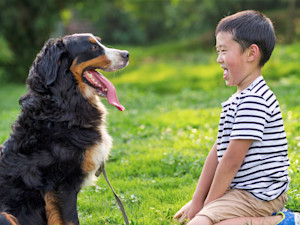Science Says: Dogs May Ward Off Baby Eczema
Study suggests dogs could reduce eczema for some kids

Share Article
All dog parents know how precious it is to watch our pets and human babies interact with giggles, kisses and love, but a new study has found that growing up around dogs could help stop some children from developing eczema.
Scientists from the Universities of Edinburgh and Bristol, the London School of Hygiene & Tropical Medicine, and Helmholtz Munich examined 18 possible environmental factors during a mother’s pregnancy and the child’s first year of life, to find out how these affected some of the genes most commonly associated with eczema.

Get (totally free) deals for food, treats, accessories, tech and way more pet parenting must-haves.
Preliminary analysis of over 25,000 individuals, all of whom were from a white, European background, indicates a potential link between seven environmental factors – having a dog, cat, or an older sibling, breastfeeding, smoking, antibiotic use and washing habits – and at least one known genetic variant associated with eczema.
When researchers then replicated the findings in a group of nearly 255,000 people, they found those with a known risk factor for eczema – a variant of a gene involved in immune cell function and inflammation known as interleukin-7 receptor (IL-7R) – were less likely to develop the condition if they had lived with a dog in their early lives.
Further lab tests confirmed that molecular signals from a dog worked to suppress skin inflammation.
Also known as atopic dermatitis, eczema is that irritating, chronic skin condition characterised by dry, itchy and inflamed skin. Although it affects people of all ages, it is most commonopens in new tab in children – around one in fiveopens in new tab have the condition.
While at times, eczema may look like red patches of inflamed skin, at its worst, the skin can crack and break from scratching, leaving it vulnerable to infection.
It’s much more than an irritating condition a child will most likely grow out of – it can hugely impactopens in new tab a child’s quality of life with sleepless nights itching, difficulty concentrating, embarrassment and missing out on school.
While symptoms can be managed, the condition isn’t curable. But this new study shows that simply having a dog in the house during the most formative years of a child’s life, could help to prevent eczema in some childrenopens in new tab genetically prone to the condition.
However, it’s worth noting that the study only looked at individuals from a white, predominantly European background and more research is needed to look into the effects on different skin colours and ethnic backgrounds. The study didn’t look at the effect of dog exposure for existing eczema – there is a potential that bringing a dog into a home with a child with eczema could worsen the conditionopens in new tab – but early analysis at a genetic level is promising.
“We know that genetic make-up affects a child’s risk of developing eczema, and previous studies have shown that owning a pet dog may be protective, but this is the first study to show how this may occur at a molecular level,” Professor Sara Brown of the Institute of Genetics and Cancer, saidopens in new tab in the report’s release. “More work is needed, but our findings mean we have a chance to intervene in the rise of allergic disease, to protect future generations.”
This isn’t the first study examining the impact living with animals has on children’s immunity. Exposure to dogs and farm animals during the first year of life has been previously shownopens in new tab to reduce the risk of asthma in 6-year-old children.
In 2016, a group of scientistsopens in new tab released a study about the Amish communityopens in new tab, a group of traditionalist Christians who uphold a simplicity and harmony with nature, including animals, concluding that Amish children have a lower risk of allergies because of the way the environment shapes their innate immune systems. Immune-related conditions that begin in childhood have increased since the 1960sopens in new tab, but not among Amishopens in new tab communities, who mostly live alongside animals.
Immunologists foundopens in new tab that children who grew up on Alpine farms who live in close proximity to cows, were protected against asthma, hay fever and eczema.
Another studyopens in new tab concluded that the prevalence of allergic disease in children ages seven to nine reduces with the number of household pets living with the child during their first year of life, suggesting a “mini-farm” effect, whereby cats and dogs protect against allergy development.
The reasons for this protective factor of living among animals at a young age hasn’t been clearly identified. Some scientistsopens in new tab suggest that exposure to a variety of bacteria at an early age, through contact with dogs and even other children, could be behind the protective effect.
Others have supposed that pets’opens in new tab microbes from their fur and paws are transferred to their humans – eventually ending up in the gut, which hosts a large concentration of our body’s immune cells.
And some thinkopens in new tab that since our human immune systems got so used to seeing domesticated animals, when we see them now, it triggers beneficial immune development.
Whatever the reason for the immunity boost associated with living near animals, it’s a huge plus that animals are not only our best friends, but now they’re being shown to be a protective force for our immune systems, too.
Resources
Cox, David. “ How Your Pets Alter Your Immune System.opens in new tab” Bbc.co.uk, BBC, 3 June 2025. Accessed 6 June 2025.
Fall, Tove, et al. “ Early Exposure to Dogs and Farm Animals and the Risk of Childhood Asthma.opens in new tab” JAMA Pediatrics, vol. 169, no. 11, Nov. 2015, p. e153219.
Hesselmar, Bill, et al. “ Pet-Keeping in Early Life Reduces the Risk of Allergy in a Dose-Dependent Fashion.opens in new tab” PLOS ONE, edited by Lucienne Chatenoud, vol. 13, no. 12, Dec. 2018, p. e0208472.
Illi, Sabina, et al. “ Protection from Childhood Asthma and Allergy in Alpine Farm Environments—the GABRIEL Advanced Studies.opens in new tab” Journal of Allergy and Clinical Immunology, vol. 129, no. 6, June 2012, pp. 1470-1477.e6, . Accessed 26 Jan. 2021..
“ Information for Parents and Children.opens in new tab” National Eczema Society, 10 Feb. 2020, .
“ Eczema in Children: Uncertainties Addressed.opens in new tab” NIHR Evidence, 19 Mar. 2024.
Nelson, Steve. “ You Want a Dog. Someone in Your Home Has Eczema. What Do You Do?opens in new tab” National Eczema Association, Aug. 2022.
NHS . “ Overview - Atopic Eczema.opens in new tab” NHS, 6 Sept. 2024,
“ Pet Dogs Could Combat Genetic Eczema Risk in Children.opens in new tab” The University of Edinburgh, 3 June 2025.
Platts-Mills, Thomas A. E. “ The Allergy Epidemics: 1870-2010.opens in new tab” Journal of Allergy and Clinical Immunology, vol. 136, no. 1, July 2015, pp. 3–13.
Stein, Michelle M., et al. “ Innate Immunity and Asthma Risk in Amish and Hutterite Farm Children.opens in new tab” New England Journal of Medicine, vol. 375, no. 5, Aug. 2016, pp. 411–21.
Tantoco, Jamee C., et al. “ The Amish Have Decreased Asthma and Allergic Diseases Compared with Old Order Mennonites.opens in new tab” Annals of Allergy, Asthma & Immunology, vol. 121, no. 2, Aug. 2018, pp. 252-253.e1.

Lauren Crosby Medlicott
Lauren is a freelance journalist who lives with her family and black labrador, Betsie, in the south Wales valleys. When she’s not working, she loves going for a dip in a nearby river and hiking in the Brecon Beacons.
Related articles
![woman hugging a Dalmatian]()
Dalmatians May Be the Key to Spotting Genetic Diseases, Say Scientists
Those spots aren’t just for show...
![Dog and child looking at each other sat on the grass]()
Real-Life Puppy Love: How Dogs Bring Out the Best In Kids
A study shows cuddles with pups go beyond just comfort
![Man petting a Golden Retriever dog at home.]()
New Global Research Project Will Be the Largest Ever Study on How Pets Impact Mental Health
Mars Petcare is exploring how dogs and cats impact human well-being – and vice versa.
![Woman with ginger hair at a table with her laptop and her white dog on her lap]()
Calling All Dog Parents: Help Shape the Future of UK Dog Welfare
Any excuse to talk about your dog, right?



